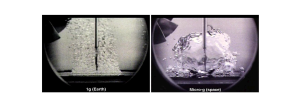About
Heat transfer is a critical management to many engineering fields, from power conversion to cooling systems. This is even more true in space, where the only source of thermal evacuation is radiation. Efficient thermal management becomes key in the design of any spacecraft. Externally, radiators are used to “vent out” the unwanted heat. In the inner thermal management system however, fluids are used to ensure convection and diffusion through the whole spacecraft and to the radiator. These inner circuits are generally in close-circuits, thus well-monitored. However, the case of hot gas propulsion faces a different configuration; going from a well pressured environment to the space vacuum while being heated. The configuration listed above brings out numerous questions. The fluid focused on this study being water, here is a sample among them : (How) is the phase transition (boiling) complete ? How is the thermal capacity affected ? Will the boiling pattern observed in this configuration be different than the one we obtain on Earth ? How does the pressure gradient affect the boiling process ? Due to the reduced amount of experimental facilities in space and the difficulty to achieve, simulation tools, if well calibrated, represent a time and cost effective first approach to such questions. Due to the difference between Earth Atmosphere and Space, more specifically low Earth Orbit (LEO), water boiling requires adapted simulation tools; as the ones used nowadays are cut for Earth application. The objectives of this project are then twofold: Identify the effects of the space environment on water boiling and its associated numerical models: Turbulence, Thermal Transfer, etc. Propose a model able to handle some specific case of water boiling in low gravity, low pressure environment.
Organisation and Partners
- University of Luxembourg and Bradford Space (external)
Project team

Prof Stephan LEYER
Full professor in Mechanical engineering – Heat and mass transfer and thermodynamics

